Abstract
In this report, I reviewed the purpose and critical objectives of human resources (HR) management and the importance of this function in the context of contemporary organisations. I developed my understanding of how the HR functions can be delivered and evaluated in organisations and how this can add value to them. Finally, I improved my knowledge of the relationship between organisational efficiency and how HR functions can enhance it.
An HR manager has a variety of tools and ways in which they can impact organisation’s performance – team building, cooperation with senior managers, collecting and presenting data, managing training and career development, establishing an accurate appraisal process, recruiting and others. In cases when the HR function is outsourced, some key elements and the value that this role provides for the organisation’s culture can be lost, which is the focus of this report.
The HR function varies between different organisations, depending on a variety of factors such as size, industry, objectives and others. The chosen organisation is a software development company that employs less than 100 people, mainly software developers and project managers, and works directly with clients on creating and implementing information technology solutions. With this company, the main objective of HR is to recruit qualified personnel and promote the existing talent to ensure that they improve their skills and qualifications.
Additionally, because the industry is competitive in terms of recruiting and retaining talent, HR has to ensure that the employees receive adequate compensation for their work and good benefits in comparison to the competitors. In contrast, a manufacturing company in the automobile industry, employing over 1000 people will pose different challenges to the HR manager, since the focus will be on ensuring that there are enough people on the production line to enable proper work of the plant and promoting the culture of safety to avoid injuries.
According to CIPD (no date, para. 1) ‘through the people professionals who work within it, the HR function helps an organisation deliver its corporate strategy and objectives by effectively recruiting and developing people and managing their performance.’ Therefore, the HR function depends on the organisation-specific factors, which makes outsourcing undesirable because these peculiarities can be overlooked by the outsourcing partner.
The HR theory is based on four key models – Warwick, Ulrich, Michigan and Harvard, and 5P. For example, in the Harvard Model, the following elements are essential – ‘situational factors, stakeholder interests, HRM policies, HRM outcomes, and long-term consequences’ (5 human resource models, no date, para. 3). If the HR manager succeeds in improving these components, then both the individual’s well-being and the organisation’s effectiveness will improve. Next, the Warwick theory was developed on the basis of the Harvard model and implied a more analytics-based approach to HR.
Additionally, Figure 1 demonstrates the different HR functions applicable to organisations. In the diagram, there are three core elements of HR – shared service, the centre of excellence, and HRBR, all of which relate to different aspects of the company’s work. For example, shared service means the direct cooperation between HR and the employees, to target the existing strategies and policies to their needs and ensure that they work at maximum efficiency. At a different level, HR works as a business partner, in direct cooperation with the executives to create a more cohesive and strategic policy for the organisation.
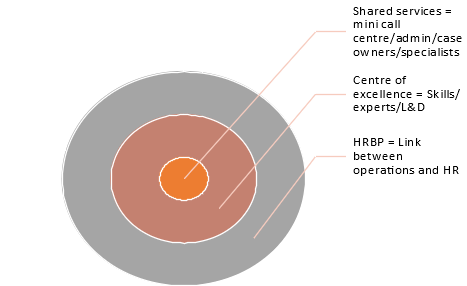
The Ulrich model mainly focuses on the people and not processes, unlike the others. The central premise is the ‘strategic partner, change agent, administrative expert, and employee champion (or employee advocate) relations (5 human resource models, no date). Hence, a role of the people in the context of an organisation are the main element considered in this model. Because of this, the HR functions are not as important, and the emphasis is on the cooperation between the HR manager and others.
Next, the 5P framework is based on five key principles – ‘purpose, principles, processes, people, and performance’ (5 human resource models, no date, para 3.). Ultimately, the focus of this model is on various organisation factors, such as the mission and vision that enable its proper functioning, such as mission, vision, and purpose. In essence, this model emphasises the long-term goals and daily operations of the business, and according to it, the ability to reach long-term objectives depends on the performance of individuals.
The Harvard model includes a total of six components and focus on the interest of stakeholders, while the Michigan model, where external or societal factors govern the management of the organisation. In essence, different types of organisations, require varying approaches to management, which is emphasised by the varied models described in this section.
- Below are the 3 examples of organisational objectives supported by HR function and that the HR is responsible for. The first responsibility is connected to delivering a variety of organisation’s functions from recruiting the right talent to managing it, enabling development, mentoring and others as demonstrated in Picture 1. In essence, all of these functions aim to add to the organisation’s performance – ensure that the people the company employs are capable of completing the tasks and developing systems and policies that will help them work and outline the culture of this particular business.
Firstly, the HR manager has to ling the firm’s HR strategy to organisations mission and vision — these are the key objectives that guide the day to day work. Next, the HR functions differ based on the size of the organisation, and other factors, such as the industry, economic sector, and the internal environment. The HR functions can help build organisations, improve, change, restructure and streamline, develop, support the human capital and their skills and recruit talent. Picture 1 displays a summary of the key HR functions.
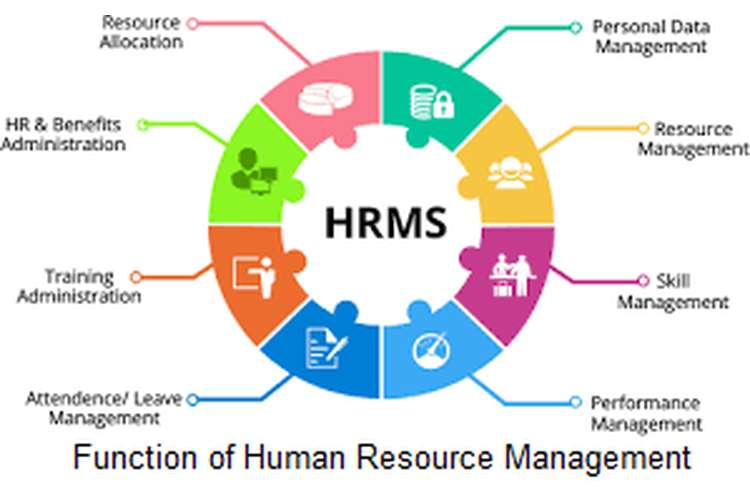
Therefore, the HR functions are interchangeably linked to the internal as well as external environment of the organisations and help support the operations by hiring and managing talent that will help the firm achieve its goals. One can define two types of HR objectives, long term and short term, with the former targeting the period of fewer than 18 months and the later — three to five years. Since the role of the these functions evolves over time, in contemporary organisations, HRs serve as leaders who can align the company’s strategy with the talent acquisition and management practices, essentially making sure that the company has the employees qualified to work on its goals.
- Learning and development (L&D) is an HR function that implies a direct cooperating with the employees to help them enhance their skills and improve their knowledge, which will result in the organisation possessing a more significant number of qualified professionals. This function evolved over time both for the HR professionals and for the employees. In the past, HR would be responsible for providing training, and their role changed only in the past 30 years (Lloyd, 2014). In contemporary organisations, HR managers are responsible for facilitating learning – for creating plans and advocating for the additional training provided to the employees. Moreover, the employees are viewed as resourceful individuals, meaning that investment in their development can be highly beneficial for the business. In the past, the companies regarded their workers merely as a workforce or a resource, with little emphasis on development and leveraging the creativity and independent thinking (Lloyd, 2014).
- Recruitment is another essential function of the HR, which allows satisfying the company’s needs in relation to the employees that will complete the tasks on a daily basis. The basics of the recruitment process in the context of the HR functions did not change significantly over time – the main premise is to identify organisation’s needs and ensure that an appropriate number of professionals with suitable qualification is hired. The main aspect of the evolution that these HR function has undergone is the change of attitudes towards the meaning of talent for the company’s success. Now, companies recognise the importance of employees and in many cases, operate in tight labour markets where talent is difficult to find. As a result, HR functions incorporate all aspects of the businesses brand managers, to ensure that the organisation is a desirable employer, while in the past the role was not as complex and merely implied looking for and interviewing appropriate candidates.
- Absence rates improvements are also the responsibility of HRM. High absence rate is usually associated with two key factors – sickness or outside of work issues affecting the employees. Both types of events affect the organisations negatively mainly due to a need to increase spending associated with managing sick leaves and finding a replacement for the non-attending employees. An HR manager should address these problems to minimise the losses caused to the business through these issues. The first strategy that an HR manager should use is developing and communicating a clear absence policy to ensure that the employees’ rights are guaranteed, and the organisation’s interests are protected. This can be done in cooperation with the business’ leadership to discuss how the organisation can minimise the adverse consequences of absence leaves. Ensuring the adequate visibility of the policy, for example, by publishing it to the website or by distributing updates through corporate email is an effective way of communicating the absence policy.
Next, the HR manager should be able to monitor the number of absent employees and manage the statistics. This is necessary to both examine the impact that absent employees have on the business and the effectiveness of the existing strategy. An HR manager can develop KPIs, incentives and wellness programs that specifically target absence to address this problem.
As a result, an HR manager can contribute to minimising the company’s expenditures by developing a cohesive and adequate strategy for the business in relation to managing absence. Arguably, the evolution of the function over time has not been extensive, since the HR managers were always responsible for ensuring that there are enough employees to perform the daily work. However, the approaches to managing absence have changed, with more attention being dedicated to incentivising and managing the wellness of the employed.
- Firstly, a significant way in which the HR function can be delivered through HR’s contribution to the business strategy. HR managers help shape the organisation’s culture and have a direct impact ion the firm’s performance, which means that this role is interconnected with strategic objectives of the business. Hence, cooperation between the leadership of the organisation and the HR management is vital when developing both the overall organisational strategy and specific goals for the HR department in particular.
Different types of HR functions are delivered differently, and this aspect also depends on the type of company. However, one can use policies, as was described in an example of absence leaves to outline the key principles of managing absence within a firm and therefore deliver the absence leave management function. Next, by contributing to People’s strategy of the business, the HR manager can deliver the functions as well, by implementing tasks and supporting the business strategy. For example, HR managers can use data to generate insights for the business, such as wither certain KPIs help achieve better customer service.
A business case for managing HR in an ethical, professional and just manner should be the basis of work for any HR manager since the role of an HR manager is interconnected with people and organisational culture, ensuring that the organisation uses ethical and just practices are the key. When this function is outsourced, this element is lost because the outsourcing partner is unable to monitor and manage the practices within the firm to ensure that they are fair.
HR professionals are expected to be leaders in their organisations, serving as examples of ethical work. This is especially important since, in recent years, we witnessed scandals about workplace harassment and inappropriate behaviour in different industries. An employee should be able to report such behaviour to the HR manager, which implies that the latter established a trustworthy relationship with the personnel and displayed ethical and professional behaviour. According to CIPD (2020), ‘ethics are at the heart of professionalism,’ meaning that an HR manager cannot display one without the other.
In terms of a business case, ethical behaviour is displayed through corporate governance combined with corporate responsibility. This type of behaviour has to be displayed in manager’s day to day work and decisions, for example in treating the colleagues fairly and with respect, in the way customers are treated, and the company’s responsibility to the society. Many contemporary businesses even develop a corporate social responsibility strategy (CSR), where they outline how they plan on addressing social issues or minimising the negative impact of their operations. CSR is proof that a company values ethical behaviour and considers the morale of its operations.
The HRs can support the ethical and professional work of their organisation by reviewing the different lenses and scenarios. After all, one can make decisions based on the long-term or short-term gains, making an alternative decision unjust in the eyes of the employees. Hence, ethics in the business environment is a complex issue. However, HR’s efforts to support the ethical and professional culture should contribute to business development. Ethical behaviour within the organisation contributes to reaching the business goals. To summarise, HR’s have to be an example of ethical, just and professional behaviour in an organisation to support an appropriate culture within the business.
Any business has to evolve and adapt to the changing environment, the development of new technology or new best practices to stay competitive and with this, proper change practices are unnecessary to ensure that the alternations are implemented adequately. The first theory of change management is McKinsey’s 7 Model, which examines seven factors one must consider when planning a change. This model is versatile and can help determine the best strategy for implementing a ceratin solution or improve performance. The main benefit of this approach is that it helps the management to predict the effect that a certain change will have on the organisation, making it easier to address any issues beforehand. In this model, there are two types of elements – soft and hard. The former are shared valued, skills, staff and style, while the latter include strategy, structure and systems. Figure 2 and Figure 3 display the elements of the McKinsey 7S model
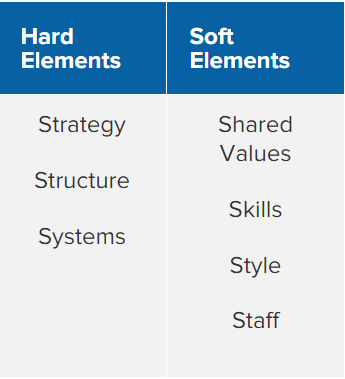
Notably, the hard elements can be easily influenced by the management, while the soft elements are not tagine and are affected mainly by the company’s culture. Evidently, when managing change, one should pay attention to the soft elements and how they align with the new strategy because if the case of a conflict, they may become a serious barrier for the implementation.
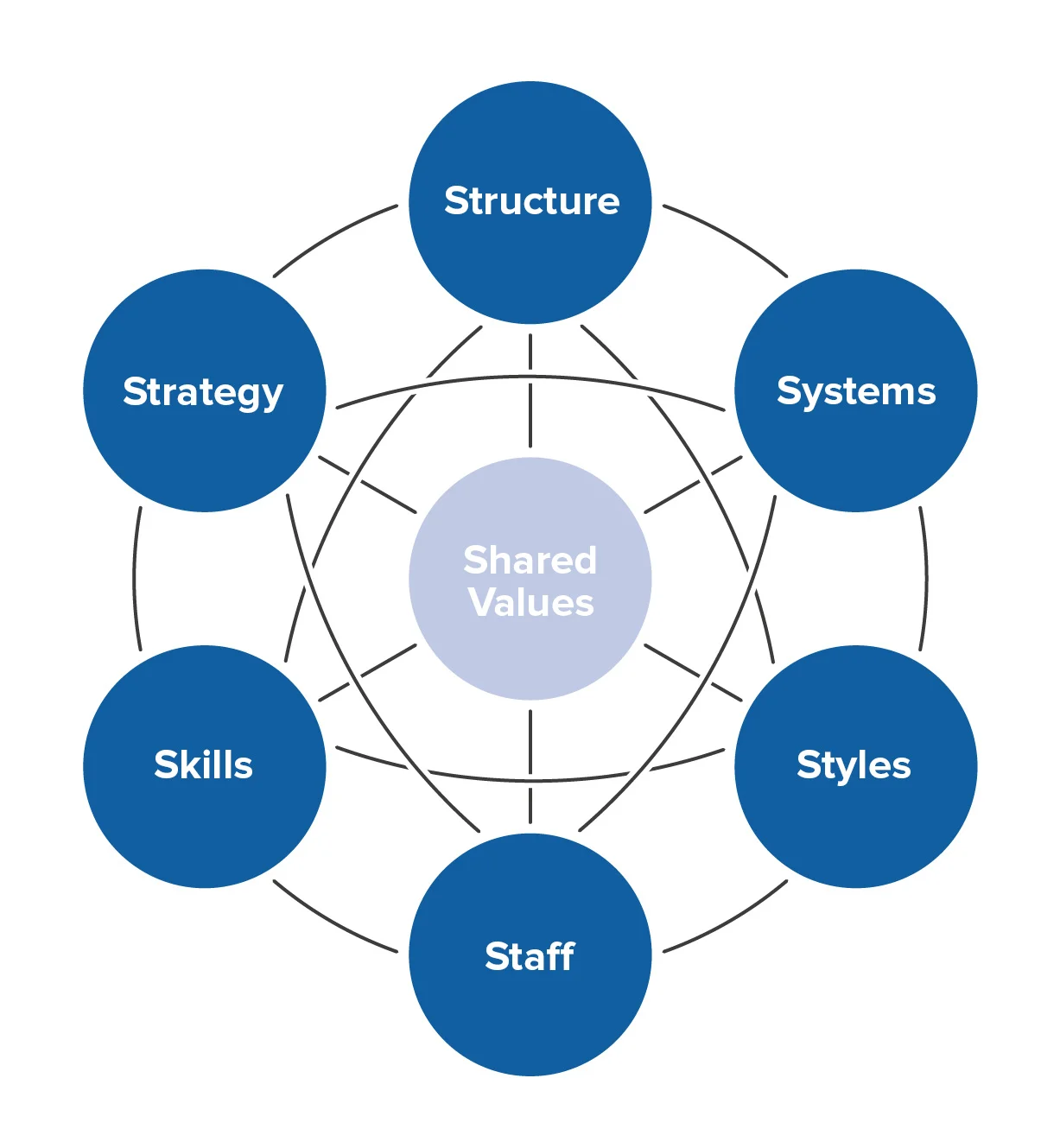
The second change management theory is Lewin’s three-step model, which highlights an important element of change management. According to this change model, each initiative undergoes three stages – unfreeze, change and refreeze. Initially, all change initiatives are faced with resistance because the employees may not understand their value of view the alterations as something that imposes additionally and unnecessary work on them. Hence, they may be resistant to accepting the change, and thus the process will become much more difficult. At this stage, the manager’s role is to clarify all the aspects of the change initiative, establish clear communication and work on clarifying all aspects of the initiative. Once these concerns are addressed, the management can begin to implement the new strategies that ‘unfreeze’ the process.
A good example of proper change management is an initiative implementing new KPIs that will incorporate customer’s ratings for sales representatives. The KPIs, of course, are typically tied to one’s benefits, and therefore, employees who worked without these KPIs may feel that their benefits will be reduced because of the new system. However, the goal of this strategy is to improve customer relationships by incentivising the employees to pay more attention to the customers.
Hence, using Lewin’s model one can state that at the ‘unfreese’ stage, it is necessary to talk to the sales representatives and explain the purpose of the new system to them. At the ‘refreeze stage’ it is essential to work on normalising the changes and ensuring that they become the new normal routine for the employees. In general, the metaphor of an ice cube that is moulded into a new shape, which is often used to describe Lewin’s model accurately depicts the change process in an organisation – it cannot be forced. Otherwise, the cube will break, or the organisation will face multiple issues with its employees.
Evaluation of the process, outcomes and impact can be made in retrospective, while examining the effect that this change had on the organisation and its processes.
The criteria or methods used to evaluate the contribution of HR’s to the organisation are developed based on the strategic vision and the type of factors that can be used to measure the HR’s input, for example through benchmarking or KPIs. The only way of objectively assessing the impact that HR functions have on the organisation is by receiving data, qualitative or quantitative.
Examples include surveys, data on engagement, metrics, such as absence or turnover rates. Measurement tools that are more strategically oriented are dashboards, benchmarks or a balanced scorecard, where each goal of the organisation is outlined, with the success criteria. By comparing the actual outcomes with the metrics outlined in one of the three tools, one can make a conclusion regarding the effectiveness of the current HR policy.
For example, HR can look at survey results to collect and analyse data about the company’s brand. Additionally, reviewing KPI reports can help understand whether the performance of the employees is good, and whether the HR is fulfilling their role. L&D evaluations are another example of such reports that can help understand the contribution of HRM for the development of human resources.
Within a hypothetical report, one can present the results of surveys, KPI reports, dashboard summary or a balanced scorecard to showcase how HR contributed to the organisation reaching its strategic objectives and by highlighting the specific decisions that allowed this. To summarise, HR managers can collect, analyse and present in the form of a report a variety of organisational data using different tools and metrics, such as benchmarking, balanced scorecards, surveys and others. Through these reports, the effectiveness of the HRM’s function can be determined, and the one can make assumptions regarding the adopted strategy – whether it is suitable considering the organisation’s strategic objectives.
The article by Kim (2013) reviews the integration of HR functions in the strategic management of an enterprise. The main objective of the researcher is to determine the mechanisms that affect the improvements in the organisation in relation to HR. The research is valid because the author uses both the theory of HR functions, such as the two ways of realising the function – strategy formulation and implementation, and
Personally, I agree with the findings by Kim (2013) because the article highlights important factor cooperation between unions and HR to create a single strategy for the firm. I think that often the union and the firm’s executives are viewed as two opposing sides that have different objectives in mind, which adversely impacts the ability to leverage the influence of the two for the benefit of the employees and the business. Hence, cooperation is the key, and the focus should be on developing the human resources, creating career development plans and implementing training programs that will help the firm have more competent human resources and the unions support the employees.
Notably, this strategy is difficult to implement if the HR function is outsourced because it would require close cooperation between three parties – management, union, and the outsourcing company. The latter would have to closely analyse the objectives of the two former members to create a suitable plan, which is possible but arguably would not be as effective as an in-house strategic HR planning.
This article is useful because it highlights the fact that HR’s functions are idiosyncratic for business, meaning that the way a company Aquarius and manages its human resources either contributes or harms its competitive advantage. The quality of this source is supported by the fact that this is a peer-reviewed article, published in an academic journal. Moreover, Kim (2013) based the findings and conclusion regarding the HR function on a survey of 210 firms. Hence the recommendations are supported by empirical research.
In this article, the HR functions are linked with the positive organisational outcomes through employee engagement, since the author proves that companies can leverage the unions to achieve their strategic goals. Notably, the findings suggest that the usefulness of the HR function for an organisation is mitigated by the involvement of the employees, meaning that in companies where employees are not engaged in the implementation of HR initiatives, the strategic function of HR is not used successfully. This article proves that outsourcing HR functions can harm the organisation because such practice implies minimising the involvement of the employees.
In summary, the main findings of this article add to the understanding of the relationship between strategic HR and performance, mainly since previous theoretical findings focused solely on the external contingencies, while this research allows one to fully understand the importance of the internal environment for HR.
As a result, one should note that apart from strategic HR, it is essential to consider the impact the firm’s employees have on its performance. Based on the survey of the firms, a conclusion can be made that despite the importance of HR, it is not authoritative and powerful when employees are not engaged in the process. Kim (2011) even tested the impact of temporary employees, which proved to have an effect on strategic performance as well. Hence, companies should build systems that allow the inclusion of employees to enable proper use of HR, which can be done through administration networks.
One issue that should be considered is the fact that Kim (2011) studied Korean film, and included only companies that had a union. Hence, there can be issues associated with generalising the results, and the outcomes may be inapplicable for non-Korean organisations without unions because of different cultures and internal organisation of the cooperation.
These findings are persuasive because the author presents the discussion of the HR function by using the example of the surveyed companies and previous theory on the subject.
Hence, this article is an example of the link between high-performance working with effective HR services and human capital as well as building organisational capability. The high-performance working (HPW) and investment in human capital can affect organisations positively because the development of human resources and the focus on the aspects of work that can be improved affect the outcomes and ability to reach company’s objectives.
HPW consists of information sharing, self-directed teams, and quality circles, as demonstrated in Figure 4 and Figure 5. HOW can be defined as an approach to organisational management that strives to improve employee performance. The main focus is such case is one the management of rewards, benefits, and ensuring that ethical practices are used. HPW can support an organisation’s performance because the main objective of this practice is on performance improvement. The management should establish clear communication, an environment where the employees can speak up, plan ahead, and consider ways in which the tasks can be better performed.
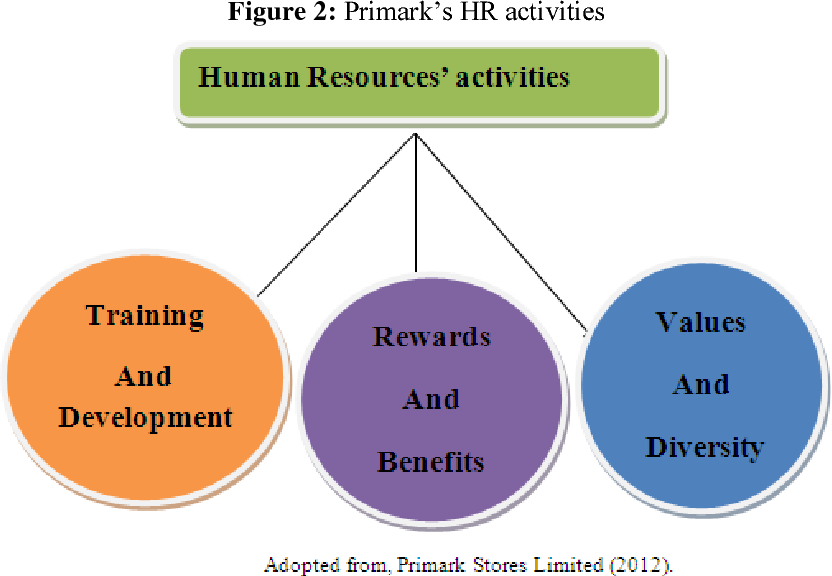
Next, investing in the development of human resources has a significant impact on the organisation since the overall competency, skill level, and professional knowledge of the organisation improves. Moreover, considering the Maslow’s needs hierarchy, individuals want to achieve self-actualisation, and professional improvement can serve as a way of reaching it, hence with the support of the organisation the employees can become more competent, which should increase their loyalty and engagement. The article by Kim (2011) clearly suggests that higher engagement results in better performance in relation to strategic objectives.
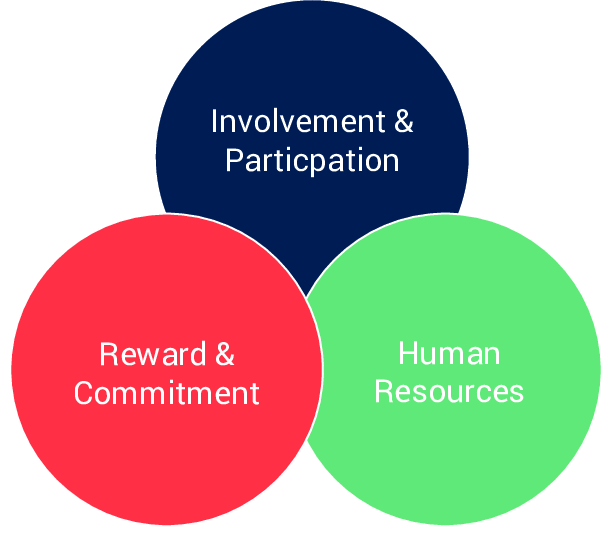
In summary, HR’s role in the HPW is connected to the impact that human capital has on the company’s success. Arguably, there is a direct link between the two elements, since the human capital can be considered a competitive advantage of a business and has a direct impact on the outcomes of work. HR affects human capital through training, recruiting people with specific skills, managing pay and rewards, which can be linked to customer service and managing performance.
These processes must align with the company’s goals, and as demonstrated by Kim’s research, it is vital to include employees and engage them in the HR and strategic process to achieve the best results with HPW.
Reference list
CIPD (no date) The HR function. Web.
CIPD (2020) Ethical practice and the role of HR. Web.
5 human resource models every HR practitioner should know. Web.
Kim, H. (2013) ‘Strategic HR functions and firm performance: The moderating effects of high-involvement work practices’, Asia Pacific Journal of Management, 30, pp. 91–113.
Lloyd, V. (2014) The evolution of learning development. Web.
